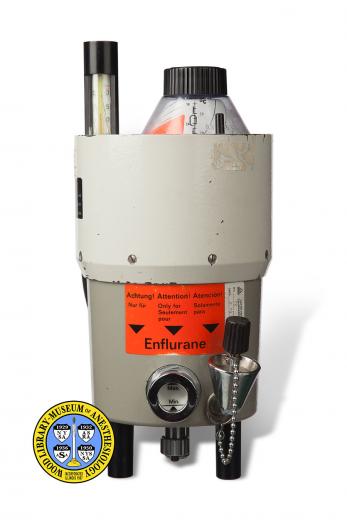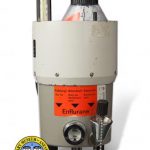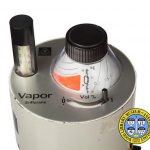Draeger Vaporizer
After the Foregger Copper Kettle vaporizer was introduced in 1952 other manufacturers responded with their own vaporizers that also allowed the anesthesiologist to precisely control the concentration of anesthetic produced. It was soon discovered that changes in gas or air pressures outside of the vaporizer, such as those from artificial ventilation, could affect the dose of anesthetic delivered to the patient. In producing the "Vapor" vaporizer Draeger aimed to create a vaporizer that could compensate for fluctuations in pressure to deliver precise anesthetic concentrations over a wide range of gas flow rates and pressure changes. They also aimed to extend the amount of time a vaporizer could produce precisely controlled concentrations of anesthetic.
The Vapor was easier to use than a Copper Kettle because it did not require complicated calculations to obtain a precise concentration of anesthetic. Each Vapor vaporizer was made to be used with only one anesthetic. The anesthesiologist only needed to turn a cone-shaped scale until the curved line indicating the desired concentration intersected with the temperature point that corresponded with the built-in thermometer. The Vapor pictured here was for use with enflurane. The first Vapors produced, in 1958, were made for use with halothane. Enflurane was not used clinically until about 1968.
Catalog Record: Draeger Vaporizer
Access Key: akdr
Accession No.: 2012-11-27-1
Title: Vapor : enflurane / Dräger.
Corporate Author: Drägerwerk AG.
Title variation: Alt Title
Title: Draeger Vapor.
Title variation: Alt Title
Title: Draeger Vapor Enflurane Vaporizer.
Publisher: Lübeck, Germany : Drägerwerk ; Telford, PA : [Distributed by] North American Draeger, [1968-1976].
Physical Descript: 1 vaporizer : metal, glass, plastic ; 29.5 x 14 x 17.5 cm.
Subject: Vaporizers.
Subject: Enflurane.
Subject: Anesthesia, Inhalation – instrumentation.
Note Type: Citation
Notes: Ball C, Westhorpe RN. Enflurane. Anaesth Intensive Care. 2007;35(3):325.
Note Type: Citation
Notes: Hill DW, Jackson DC. Recent developments in vaporisers. Anaesthesia.
1964;19(2):191-205.
Note Type: Citation
Notes: Hill DW. Halothane concentrations obtained with a Dräger “Vapor” vaporizer.
Brit J Anaesth. 1963;35(5):285-289.
Note Type: Citation
Notes: Petermann H. Der Entwicklung des Vapors. Anaesthesiol Intensivmed Notfallmed
Schmerzther. 2009;44(5):386-388.
Note Type: Citation
Notes: Vapor: Halothane Vaporizer: prospectus/operating instructions 5127e. 3rd ed.
Lübeck: Drägerwerk; 1967.
Note Type: Physical Description
Notes: One heavy, agent-specific vaporizer with moderate chipping and scratches to
the paint; The body of the vaporizer is constructed within two cylindrical
pieces securely connected, one on top of the other; The upper cylindrical
piece is approx. 14 cm in dia.; The lower piece is approx. 12 cm in dia.;
Protruding from the top of the vaporizer (or upper cylinder) is a built-in
vertical thermometer encased in thick black and clear plastic; When viewing
the face of the thermometer, the thermometer is situated on the left side of
the top of the vaporizer; It is marked with long horizontal lines numbered at
15, 20, 25, and 30 degrees Celsius, ascending from bottom to top; Short lines
indicate increments of one degree Celsius; To the right of the thermometer,
is a raised, cone-shaped scale under clear hard plastic; The scale may be
turned or adjusted via a black plastic control knob above the cone-shaped
scale; The scale is comprised of a large zero, “0”, mark and then 13 curved
lines; The numbers on the curved lines indicate concentration of the
anesthetic, in this case, enflurane; The numbers, starting after the zero are
“0,3”, “0,5”, “0,7”, “1”, “1,5”, “2”, “2,5”, “3”, “3,5”, “4”, “5”, “6”, “7”;
On the cone’s clear plastic cover is a vertical temperature scale that
descends numerically from bottom to top; Four short horizontal lines are
numbered on the vertical temperature scale; They are “28”, “24”, “20”, and
“16” degrees Celsius; Between the numbered lines are shorter unnumbered lines
indicating increments of two; Just in front of the cone-shaped scale is a
vertical lever for a slide valve; Marked on the left side of the slide valve
is the number zero, “0”, for off; Marked on the right is the number one, “1”,
for on; Marked in black on the top of the vaporizer, in front of the
thermometer is, “Vapor [new line] Enflurane”; Also marked on the top in black
behind the thermometer, is “DRÄGER”; Protruding from the front of the
vaporizer, near the bottom, is a cylindrical chamber with a glass face;
Behind the glass, a horizontal line, marked “Min.”, crosses the lower portion
of the viewable area, and a horizontal line, marked “Max”, crosses the upper
portion; to the right of the view chamber is a filling aperture; The plug for
the filling aperture is threaded like a screw, topped by a plastic knob, and
attached to the vaporizer by a short beaded metal chain; Two gas ports
protrude from the upper left side of the vaporizer, near the back; The inlet,
or port for gas flowing in, is located just above the outlet; Two black
rubber tubes, cut short, are attached to the gas ports (inlet and outlet); On
the underside of the vaporizer there are ‘legs’, approx. 4 cm in length; In
the center of the underside is a release valve for draining unused halothane;
There are markings and stickers in various places on the sides of the
vaporizer; A metal plate near the gas ports is marked with “DRÄGERWERK [new
line] LÜBECK [new line] GERMANY”, and “Fabr. Nr. 23975”; There is a sticker
marked with “Made in [new line] Germany”; Another sticker is marked with,
“EXCLUSIVE REPRESENTATION FOR [new line] DRÄGERWERK AG [new line] North
American Dräger [new line] P.O. Box 121 [new line] TELFORD, PENNA. 18969 [new
line] (215) 723-9824”; Another sticker is marked with, “THE CONCENTRATION
OUTPUT OF THIS [new line] VAPORIZER SHALL BE VERIFIED AFTER IT HAS [new line]
BEEN ATTACHED TO THE ANESTHESIA MACHINE”; Another is marked with, “Keomed Inc
[new line] Specialists in Anesthesia and Critical Care Products”; Another
sticker is marked with, “:CAUTION: [new line] FEDERAL LAW RESTRICTS THIS [new
line] DEVICE TO SALE BY OR ON [new line] THE ORDER OF A PHYSICIAN”; Another
sticker is marked with, “SERVICED BY [new line] TECHNICAL [new line] SERVICE
DEPARTMENT [new line] DATE: 11/6/82”.
Note Type: Reproduction
Notes: Photographed by Mr. Steve Donisch on January 16, 2013.
Note Type: Historical
Notes: After the Foregger Co. began producing the Copper Kettle vaporizer in the
early 1950s other manufacturers responded with their own vaporizers that also
allowed the anesthesiologist to precisely control the concentration of
anesthetic produced. It was soon discovered that changes in gas or air
pressures outside of the vaporizer, such as those from artificial ventilation
could affect the dose of anesthetic delivered to the patient. In producing
the “Vapor” vaporizer Draeger aimed to create a vaporizer that could
compensate for fluctuations in pressure to deliver precise anesthetic
concentrations over a wide range of gas flow rates and pressure changes. They
also aimed to extend the amount of time a vaporizer could produce precisely
controlled concentrations of anesthetic. The Vapor was also easier to use
than a Copper Kettle because it did not require complicated calculations to
obtain a precise concentration of anesthetic. Each Vapor vaporizer was made
to be used with only one anesthetic. The anesthesiologist only needed to turn
a cone-shaped scale until the curved line indicating the desired
concentration intersected with the temperature point that corresponded with
the built-in thermometer. The Vapor described here was for use with enflurane
The first Vapors produced, in 1958, were made for use with halothane.
Enflurane was not used clinically until about 1968.
Note Type: Historical
Notes: The German company, Dräger, has been producing popular anesthesia equipment
for over 100 years and is a leading manufacturer of anesthesia machines.
Note Type: Exhibition
Notes: Selected for the WLM website (noted December, 2012).



